HOME
"Danes Island" revisited.
- 2nd. "Danes Island" Expedition,
Nov.2003 -
After my first successful expedition
to Chang Zhou ,- or "Danes Island" -, as it was formerly known, I did not
expect to return again, since I already had accomplished what I came for.
However,- although I finally
found the old Western Cemetery, I had no idea of where exactly I found
it.
Over the time I got more and
more concerned about this, because I considered it some sort of ridiculous
to find something with great difficulty,- but actually not knowing where
exactly I found it! (Rather stupid, - isn't it?)
Driving around virtually everywhere
on this island for most of a day had made me loose my sense of direction,
and due to mist and air pollution the visibility was rather poor, which
efficiently prevented me from spotting well known features in the surroundings.
But again in 2003 I found myself
in the neighborhood of "Danes Island". My intention this time was
to do some research on other old China Trade- and Opium War locations of
great historical value, and since my work progressed very well indeed,
I decided to use the opportunity to spend some time to go back to Danes
island and see what I could find this time!
Since last visit I also had
some information from one of my countrymen residing in Hong Kong , - Mr.
Henning Hoeg Hansen -, who is writing books and has researched Chinese
burial rites.
He informed me, that the cemetery
I had "found" might NOT even be at the original place, but was relocated
and reestablish at the present location in 1980!
Also, - during the past 160
years, there are good reasons to believe, that the geography of the Pearl
River delta and its many islands and waterways had changed.
Therefore, - what we see on
old paintings of the area, might NOT necessarily be the same as what we
see today!
I simply HAD to find out!
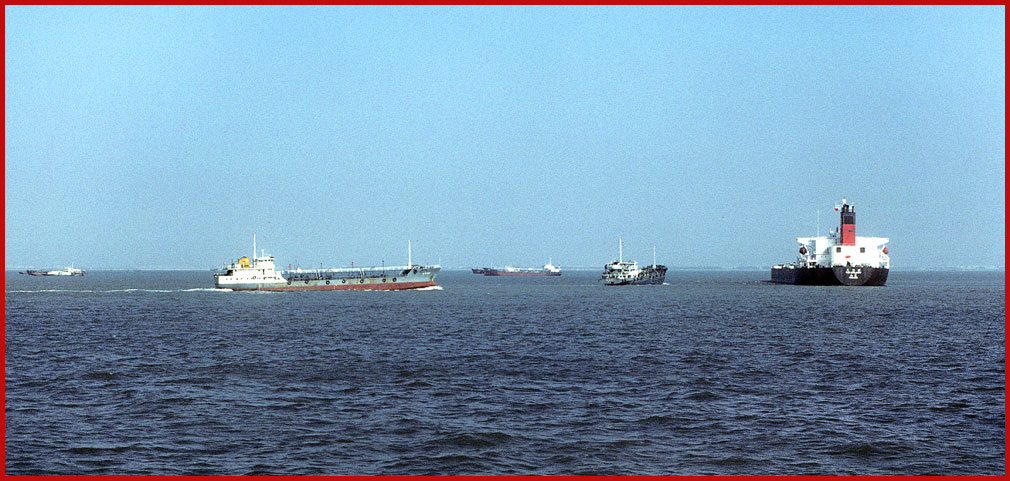
Pearl River
- once again up the Pearl River,
- heavy with traffic -
(Photography by Karsten Petersen)
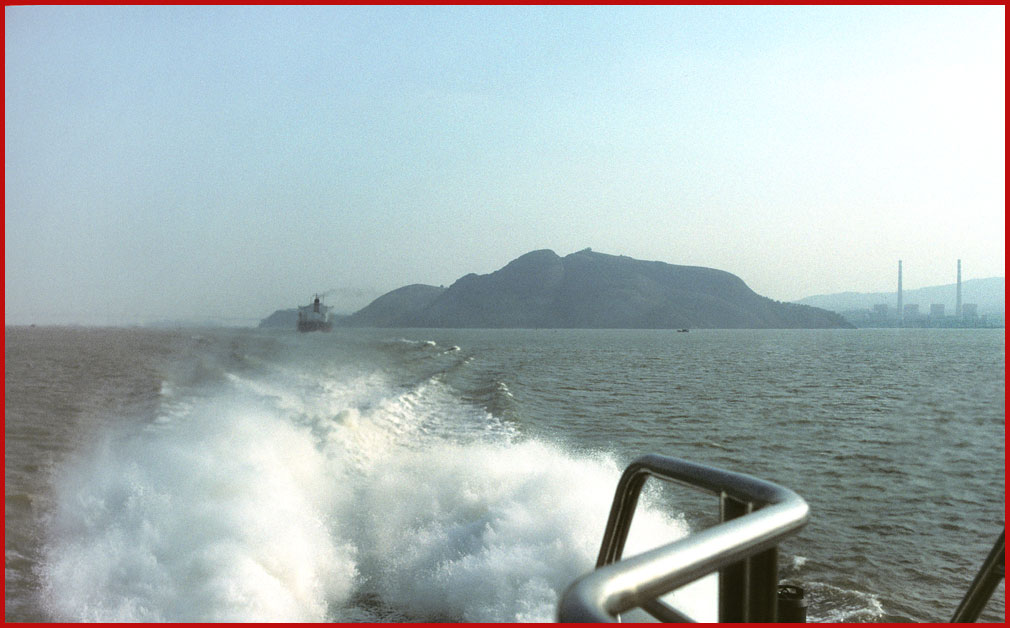
Pearl River
- passing well known Tiger
Island -
(Photography by Karsten Petersen)

The Pazhou pagoda on Whampoa
Island
On the way visiting the pagoda,
- a well known land mark and fix point for the first European navigators
-
(Photography by Karsten Petersen)
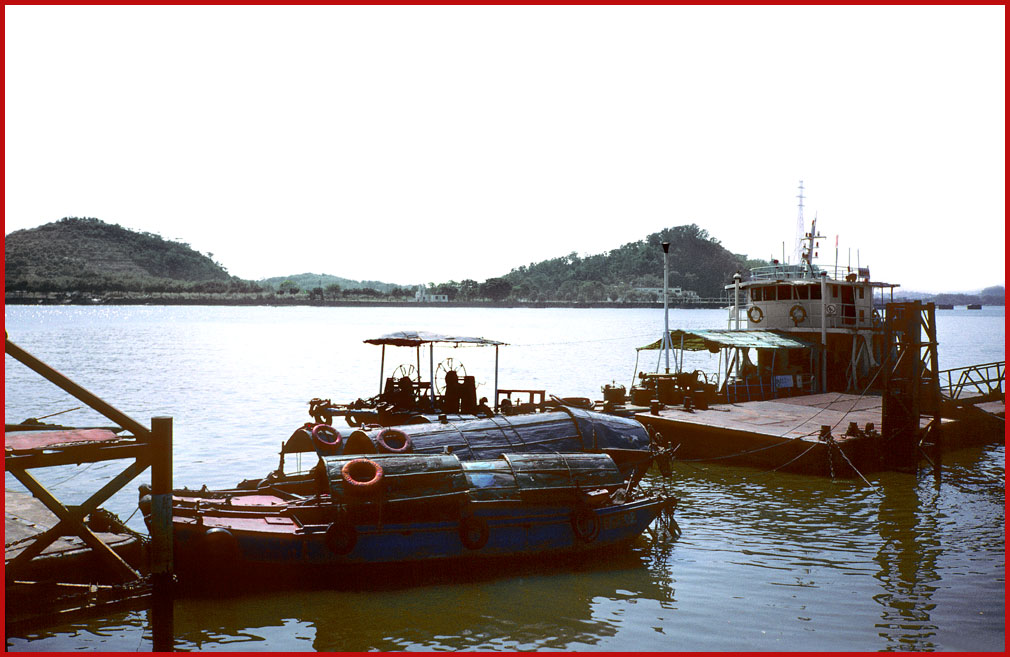
Whampoa Island, - at the ferry
station to Danes Island.
- Danes Island in the background,
- showing Cemetery Hill behind the small river boat to the right -
(Photography by Karsten Petersen)
So off I went to "Danes Island"
,- this time accompanied by Kit Yu, who was very handy to have around as
interpreter!
This time my approach was from
the ferry station on Whampoa island just across the water from "Danes Island",
- and very near the old Western Cemetery -, so this time it was no problem
to find the place.
The difference between last
visit was, that now it was Kit Yu, - and not Xiao Ling -, who was
riding the motor bike in front of me, and this time the weather was very
good, with clear, blue sky, and and an unusual good visibility!
Perfect!
Also we got there a lot easier,
and only had to walk in the bamboo groves for a short time before I recognized
the surroundings from my previous visit.
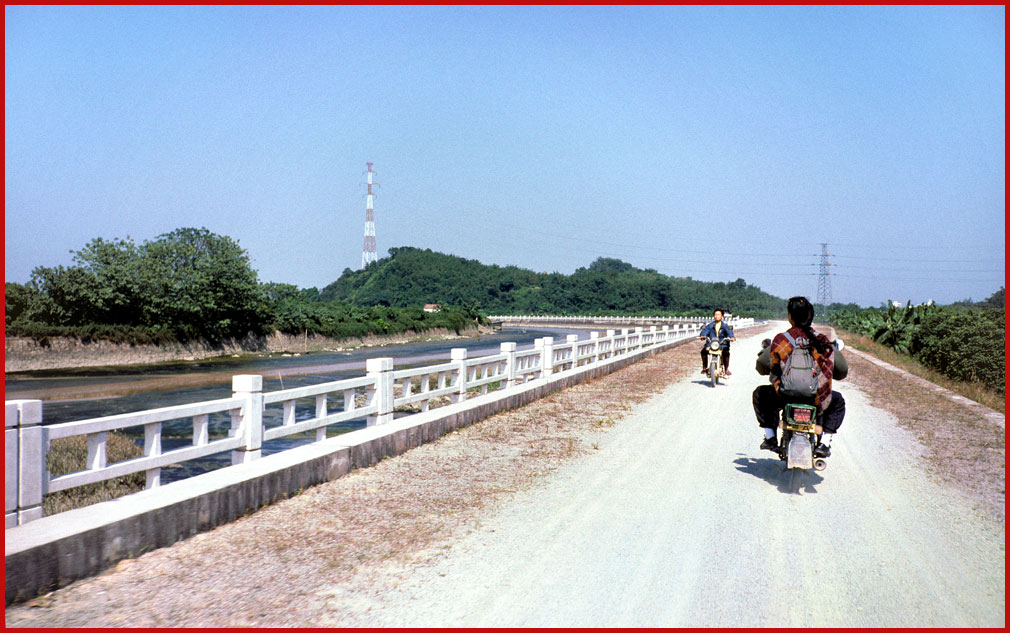
Danes Island
- Kit Yu in front on the way
to Cemetery Hill -
(Photography by Karsten Petersen)
This is a new road following
the present days canal separating Danes Island to the right from French
Island to the left. The grave site is on the mountain in the background,
just below the red and white coloured mast.
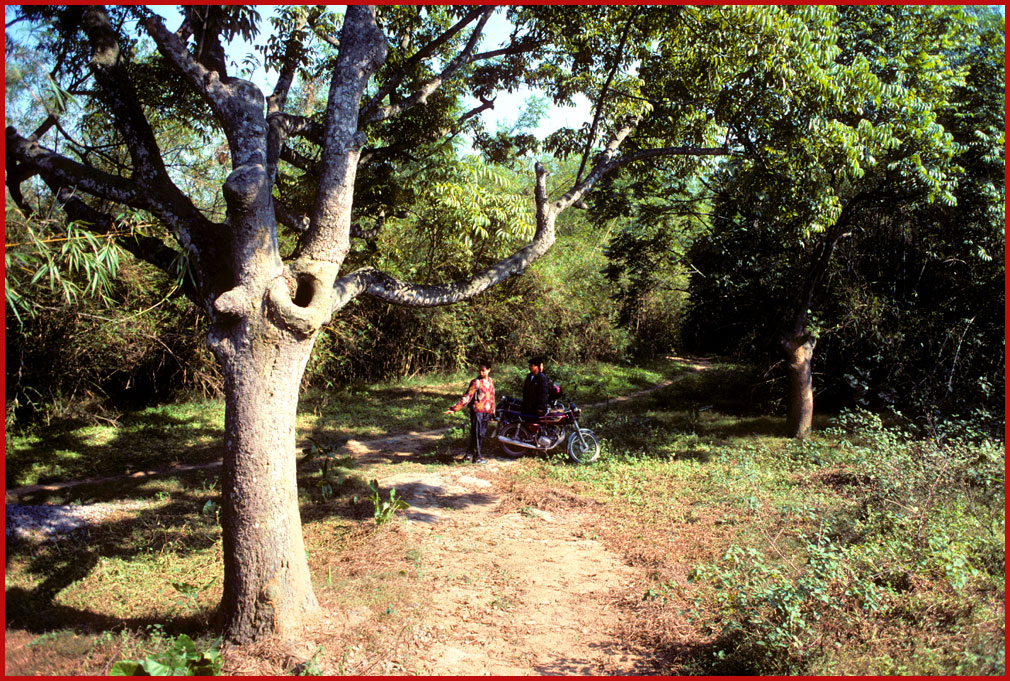
Danes Island
- end of the trail , - from
here we had to leave the bikes and walk to the grave site -
(Photography by Karsten Petersen)
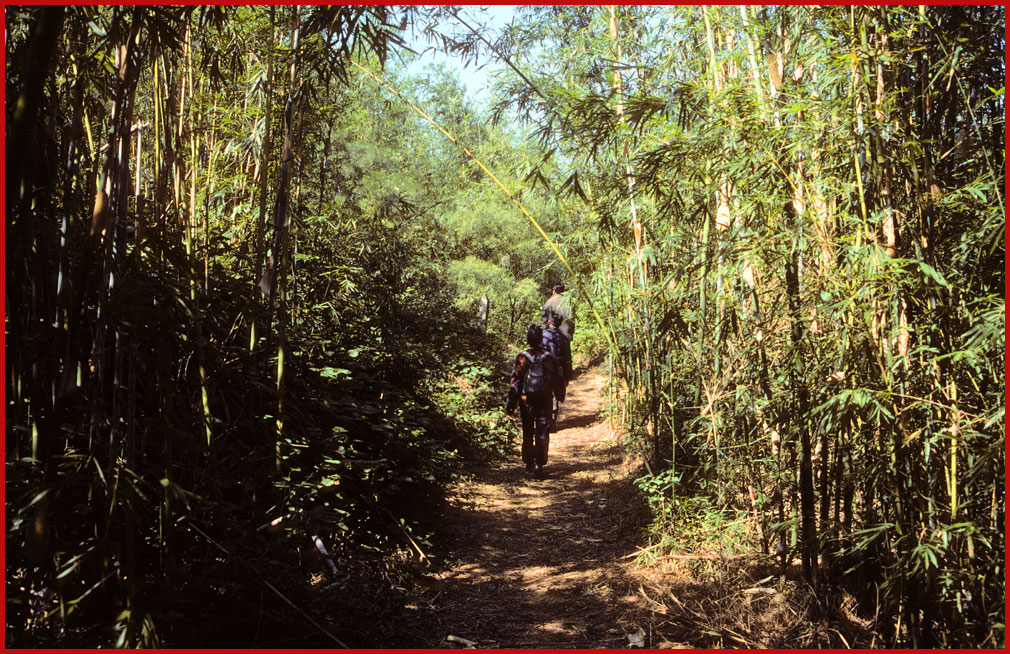
Danes Island
- through the bamboo grooves
on the hill side -
(Photography by Karsten Petersen)

Danes Island
- and suddenly we are there!
(Photography by Karsten Petersen)
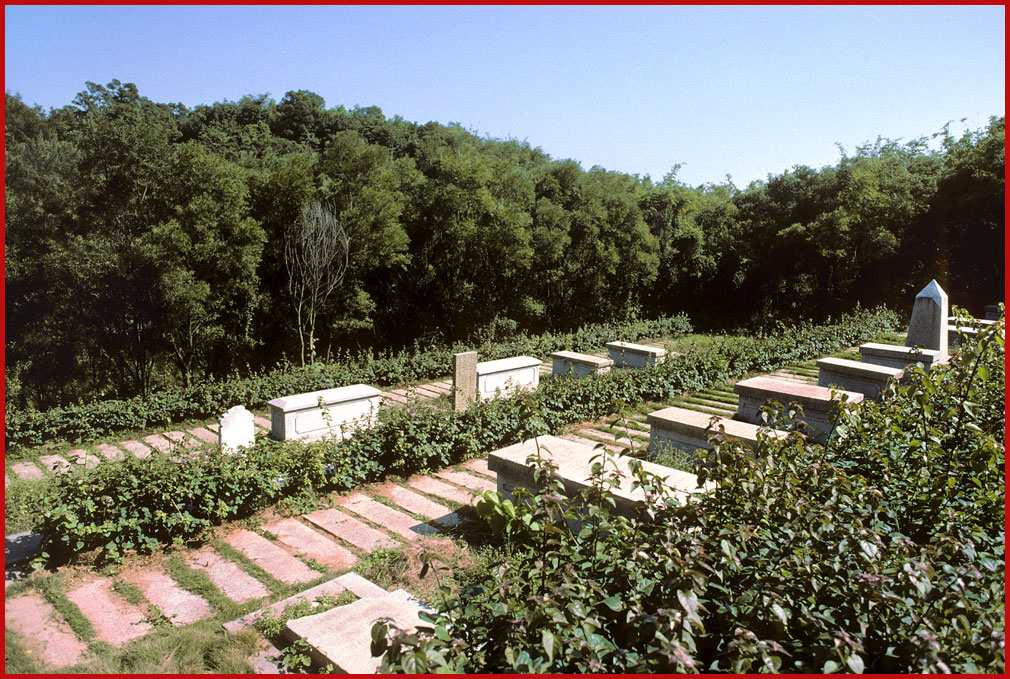
Danes Island
Revealing a view over the neatly
restored tombs -
(Photography by Karsten Petersen)
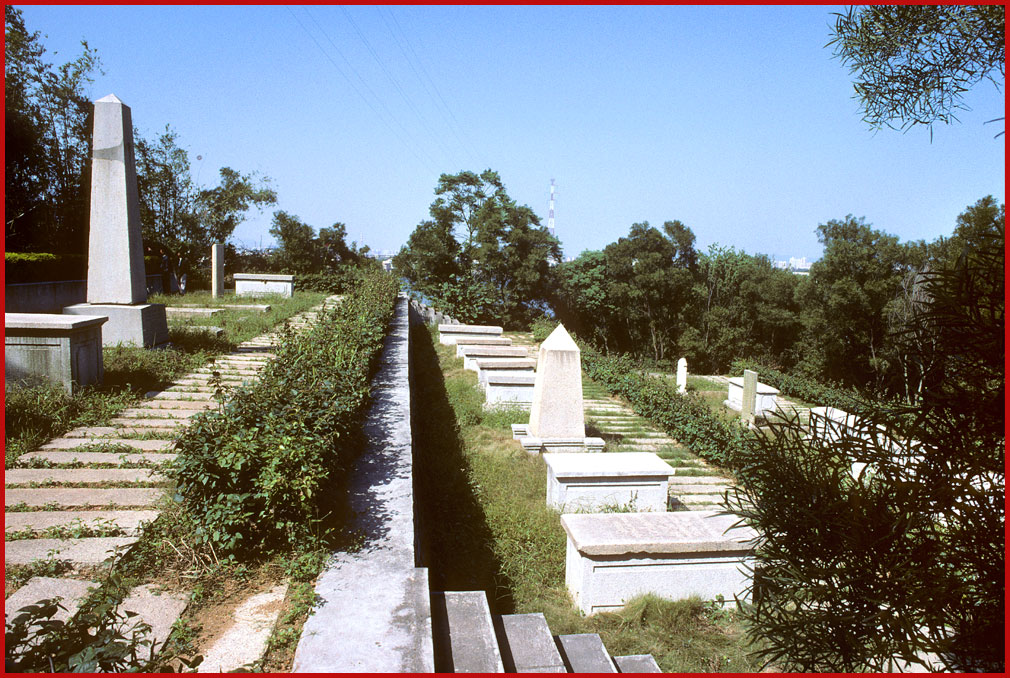
Danes Island
- and another view -
(Photography by Karsten Petersen)
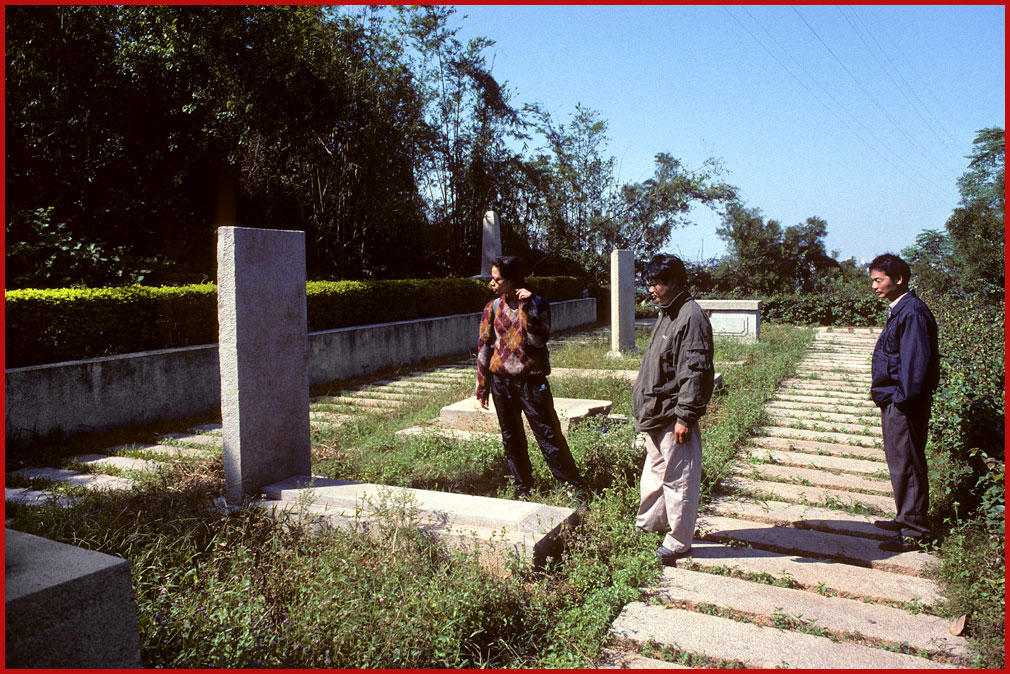
Danes Island
Here a Danish grave,- the one
of Andreas Allewelt, - a well known trader.
(Photography by Karsten Petersen)
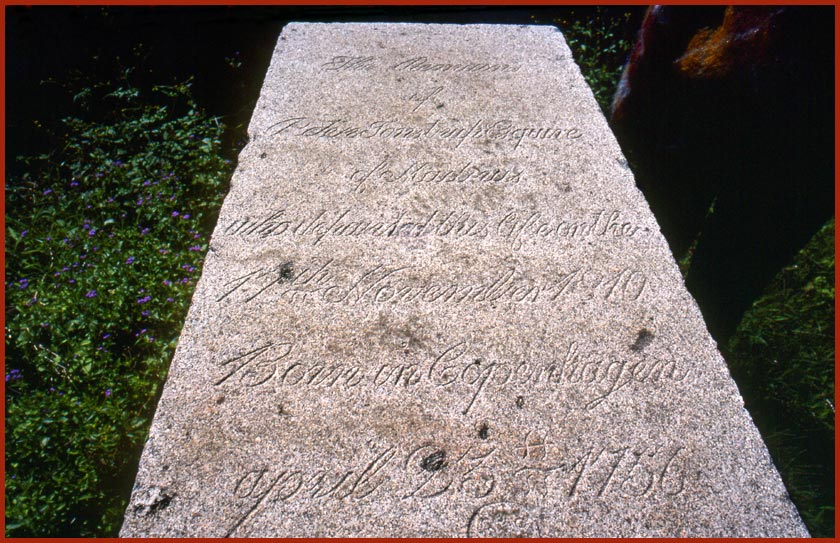
Danes Island
Here the tomb stone of another
Danish gentleman, - Mr. Peter Tonstrup -
- born in Copenhagen in 1756,
and buried here on the China Coast in 1810.
(Photography by Karsten Petersen)
But now came the question about
the grave site itself.
I wanted to find the exact
location and the position from where the artist painted his picture way
back in 1850 - -
I simply HAD to
find out - - - -
I climbed the mountain top above
the grave site,- and due to the unusual good visibility, I could easily
survey the landscape, the Pearl River and the islands.
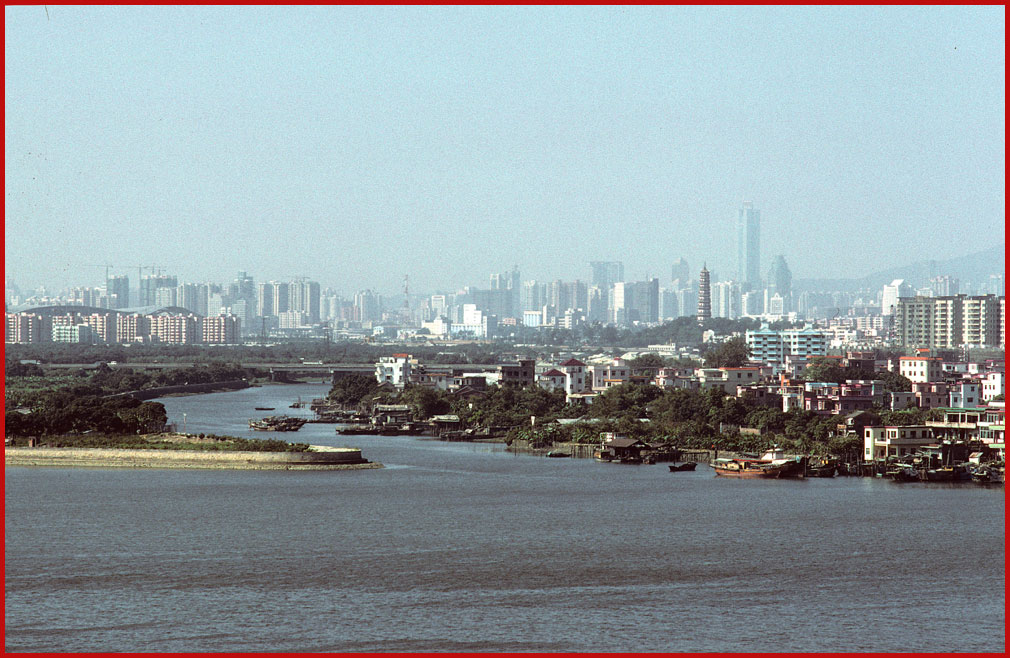
View into "Fiddlers Reach"
A view from the top of "Cemetery
Hill" in year 2003, - surprisingly similar to the view in 1850!
View into "Fiddlers Reach"
(Photography by Karsten Petersen)
It did indeed look very much
as the view shown on my painting.
The Pazhou Pagoda,- better
known as the Whampoa pagoda, and well known navigation point for the early
navigators -, could be easily seen on its small hill, although it was now
surrounded by buildings, and instead of being right near the water, it
now appeared to be much further inland.
Indeed, - the landscape had
really changed during the last 160 years.
Also the slopes of "White Cloud"
mountain could be seen behind the pagoda! Now obscured, - not by mist -,but
by Guangzhous skyline of modern high rise buildings.
But again exactly as on my
painting, with the top of "White Cloud" mountain to the right!
Also the view into "Fidler's
Reach" fitted in very well.
And,- of course-, the river
arm ,- "French Reach" -, as seen in the foreground to the left on the painting,
apparently was there as well! ( Later I found out, that it was in
fact NOT French Reach I saw!)

Danes Island view
Here a closer view of the old
Whampoa pagoda - -
Note that the slopes of "White
Cloud" mountain is there, but obscured by Guangzhous skyline - -
(Photography by Karsten Petersen)
At that time I was almost convinced
that I really was on the right spot,- but one important thing did NOT fit
in!
My painting,- and numerous
other old paintings of the same area-, was all painted from a mountain
position behind and above "Cemetery Hill",- but this mountain seemed to
be totally absent!
It simply was NOT there,- and
nothing suggested that it had ever been - - -
Artistic freedom could explain
the absence of the mountain, because the scenery is so much better if seen
a little bit from above,- so it could very well be artistic freedom, that
made the old artists paint the scene the way they did way back in the 1800's!
But they ALL painted the scenery
like that! Without any exception - - - -
Furthermore, - they usually
painted every detail very accurately, so there was a "problem" here
with the missing mountain behind the cemetery.
However,- very near the present
cemetery, - a little to the north- east -, there was a mountain that fitted
in perfectly when it comes to the right view point, but then again,-
other things did NOT fit in!
Most disturbing was, that "Cemetery
Hill" was totally missing,- and so was "French Reach", although there was
water in form of a closed port area, now being used by a modern shipyard,
and as landing place for the small local ferry from Whampoa Island!
Here a view from the present
"Cemetery Hill" towards that mountain a little further to the north-east,
which fitted in very well as the spot from where the old artists had painted
the scenery - - -
A crane and some buildings
from the modern shipyard can be seen below the mountain.
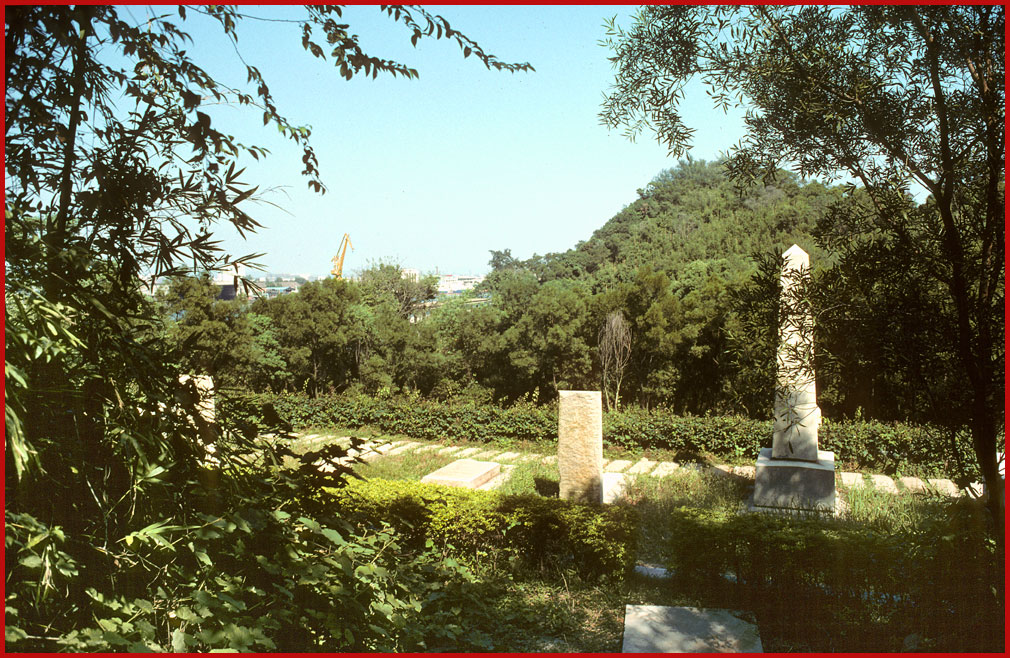
Danes Island
- view towards the small mountain
that looked very promising, - and the shipyard -
(Photography by Karsten Petersen)
So, - "French Reach" was missing,
although it could over the years have been replaced by the present harbour.
Only problem was, that the
harbour was closed, and did NOT go all the way into Blenheim Reach, - the
waterway that borders Danes Island to the south - -
Therefore,- something did not
really support the theory, that this small mountain was the place
from where the old artists had made their paintings - - -
But one thing looked good -
- -
The river arm,- "Fidler's Reach"
-, seems to fit in much better than it did from the present "Cemetery Hill",
but again,- this could easily be explained by small changes in the landscape
during the last 160 years.
So the question remained:
From exactly which location
did the artist actually paint the picture????
While being there,- I concluded
that the cemetery was indeed on the original spot, because more things
seemed to fit in,- compared to things that did not fit in!
But the last checks was done
after I arrived home!
I simply mobilized all the
maps I had of the area,- from very early maps, to maps from the 1840's
and up to modern days maps of the area and Guangzhou City.
When comparing the maps it really
struck me how different "Danes Island" looked on the different maps from
different periods of time.
It seemed to be smaller and
differently shaped on the older maps,- and not two maps were completely
similar - - -
This ,- of course-, could partly
be explained by the inadequate survey methods of that time,- but as Henning
Hoeg Hansen of Hong Kong had suggested to me,- it certainly could be because
the present landscape has changed a lot during the last 160 years!
But before I checked that out,-
I tried to draw lines in my modern map, based on bearings from different
positions.
The only points that had NOT
changed during the time, was the position of the Whampoa Pagoda and the
"White Cloud" mountain.
Lines drawn through those fix
points revealed, that actually BOTH possible position of the cemetery could
be correct. Only I had some doubt, that the mountain slope I could
see on my photos , might NOT be "White Cloud" mountain,- but maybe another
one? Also I could not see the top of the mountain.
Therefore I also used a new
fix point,- the position of the very tall building which you can see a
little to the right on the photographs showing the view from "Cemetery
Hill". Of course this building was not there for 160 years ago,-
but it is excellent for taking bearings from "Danes Island", since its
position is clearly marked in the modern Guangzhou city map!
But the method of taking bearings
and comparing my new photos with old paintings still had not answered my
question, since both possible positions could be correct, because they
simply were positioned so close to each other!
But which one was actually
the right one????
Now I used my computer, and
scanned pictures of several old- as well as new maps-, and could
compare directly in the same scale!
The result was interesting!
The geography of "Danes Island"
really had changed dramatically over the years!
See here what the latest chart
over "Danes island" looks like - - - -
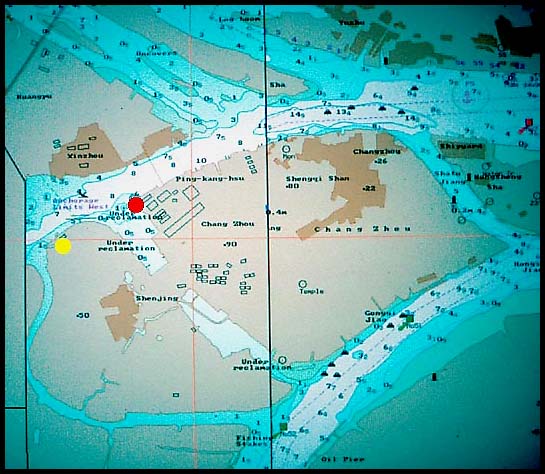
Danes Island (Chang Zhou)
Here is "Danes Island" as it
looks on the latest chart over the area.
I have market the present "Cemetery
Hill" with a yellow dot,- and the possible position of the original grave
site with a red dot
Now have a look at an old English
chart from the 1840's, - which corresponds very much to other maps from
the same period.
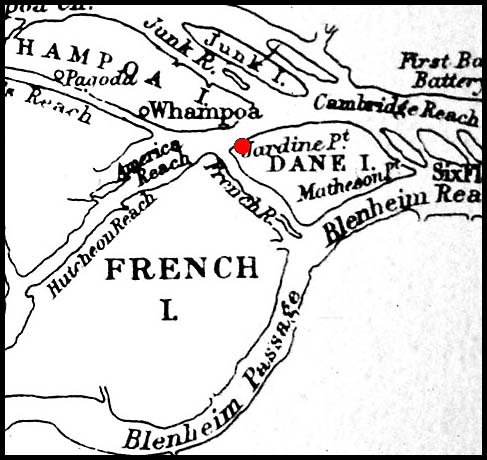
Danes Island (Chang Zhou)
- 1840's.
Here is "Danes Island" and "French
Island" clearly shown,- and it is easy to see the big difference from the
modern map.
I have marked the position
of the original grave site at "Jardine Point" with a red dot!
But now try to "correct" the
old map from 1840 so that it matches the new chart,- and see what you get!
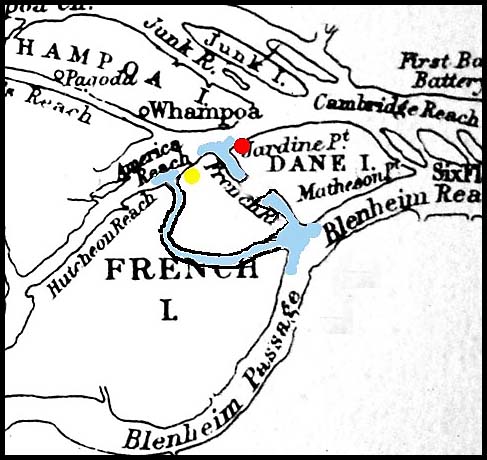
Danes Island (Chang Zhou)
Here the "corrected" map,-
a combination of map making of 1840 and year 2003.
"French Reach" is now partly
filled in,- forming the port used by the shipyard and as ferry station
for the Whampoa ferry. A new "French Reach" has appeared a little
further south!
Again the yellow dot marks
the present position of the cemetery,- and you will see, that although
it is actually positioned on "Danes Island",- on a piece of "reclaimed"
land - , then the modified map clearly suggests, that this position was
earlier a part of "French Island"!!! Confused anyone????
Well,- no wonder!
Conclusion???
Well,- the scenery as shown
on my painting, MUST have been the view from the present hilltop just behind
the ship yard and the red dot shown on the above maps!
But many years after the painting
was painted in 1850, - the small hilltop with the tombs has completely
disappeared!
The hill has been leveled,
and a modern shipyard has been built on the site!
Since nothing was left from
the original cemetery, the Chinese authorities have rounded up as many
of the old original tombstones as they could find, and reestablished the
cemetery on its present position in 1980.
However,- I still believe, that
the "new" site is actually not new,- but another grave site from the heyday
of the China trade.
I base that conclusion on the
fact, that NOT all graves in the area are restored!
In fact there are several very
old looking stones to be found just outside the rim of restored graves.
Those tomb stones are not standing nice and vertical, in straight lines,
but slantwise scattered around at random, and partly overgrown by the vegetation.
See following photo of one such
stone,- and judge for yourself - - - -

Danes Island
A very original looking tomb
stone - - -
(Photography by Karsten Petersen)
Based on above, I therefore
believe, that originally there must have been TWO separate grave sites,-
one on "Danes Island" and one on "French Island".
Now the original site on "Danes
Island" has completely disappeared,- and the remains have been transferred
and reestablished at the original site of a similar cemetery on "French
Island",- which has now become a part of "Danes Island"!
Yes!!! It is complicated
indeed - - - -
Whatever the truth is behind
this story, then I have now obtained complete peace in my mind!
And whenever I now pass my
painting of the view from "Danes Island", I truly can say: "I were
there"! ( Maybe????)
Here once again is the terrific
view that started it all, - and please try to compare the view with the
following photograph, - which was also shown earlier on this page!
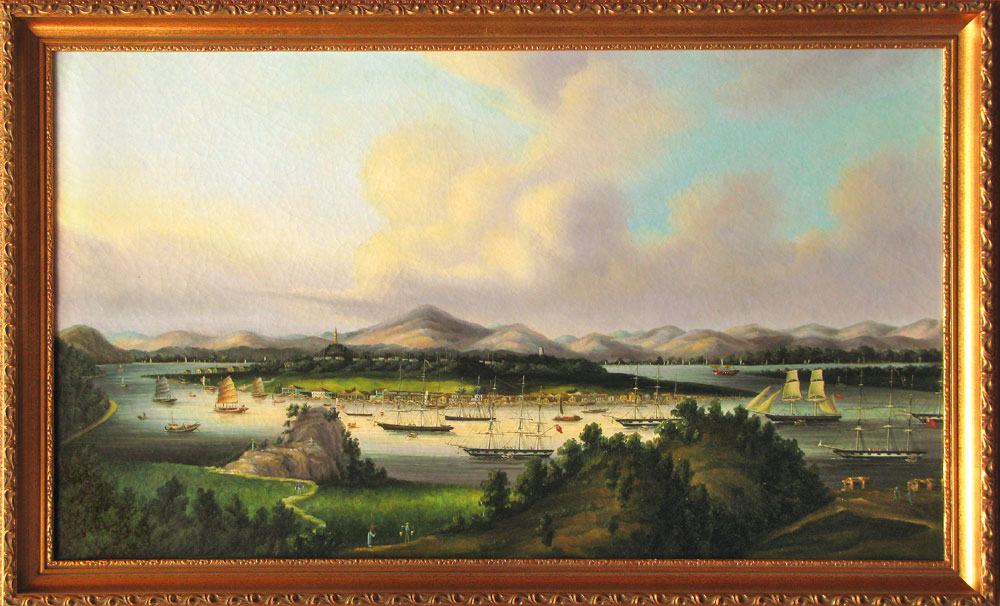
Danes Island - the Huangpu
Anchorage 1850 -
View over English Reach towards
Whampoa Island with Fiddlers Reach and the Whampoa (Pazhou) Pagoda -
(Painting: From the web masters collection.)

View from Danes Island into
Fiddlers Reach, - and to the Whampoa pagoda
(Photography by Karsten Petersen)
See the striking similarity?
Finally another old map
showing my final (?????) conclusion!
I am quite sure, that the artist
who painted the picture, MUST have been sitting somewhere on the small
mountain marked with a red ring around it!
And the "Cemetery Hill" he
painted, - marked with yellow-, MUST have been in front of this mountain
at Jardine Point!
Please have a look at the following
old map with my markings - - -
The Final Conclusion
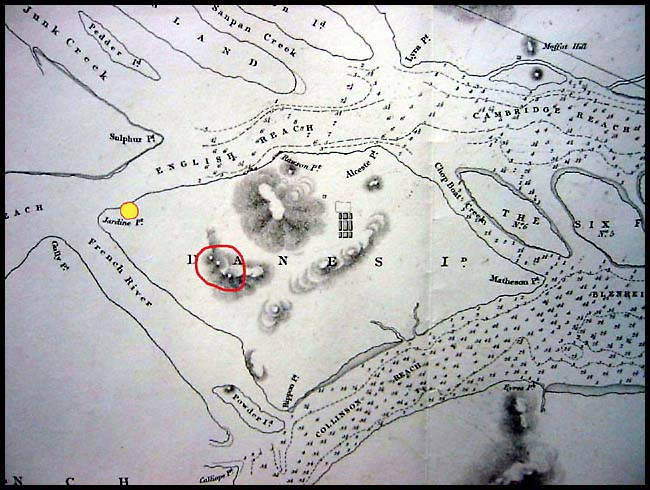
Danes Island (Chang
Zhou)
The artists viewpoint, - marked
with a red circle -, when he painted the original picture!
The yellow dot at Jardine Point
is the position of the original cemetery as seen on the painting.
The Whampoa Pagoda
Over the years I have been navigating
the Pearl River in almost any imaginable type of boat, like ferry from
Hong Kong, fast outboard powered small open boats, - local ferries between
the Pearl River islands, - local ferries from mainland to Pearl River islands,
- local water taxies and , - of course -, big modern merchant ships.
But regardless of how I navigate
this river, - and what type of craft I use -, the sense of history is immense.
It hits you like a hammer -
- - -
It seems as if the big modern
merchant ships of all types, the small local ships and the fishing boats
suddenly disappear in the mist, and by some sort of magic they are suddenly
replaced by the great trade frigates of the 18 hundreds, - the super fast
opium clippers, and the just as fast, sleek tea clippers and lots of Chinese
junks with coloured hulls and sails - - - -
It's strange and fantastic
- but this feeling comes every time - - - Apparently it is unavoidable
- - -
When passing the "Solitary
Nail" I really see the fleet of opium clippers around the island, and when
passing the fortifications at the "Tigers Mouth", - Bocca Tigris -, I can
actually hear the noise of gun shots and feel the canon balls fly over
my head - - - -
But only the pagodas I see on
the way up are not fantasy or imagination,- they are still there, - very
real -, just as they were real and important land marks for the early western
sailors and traders, that hundreds of years before me struggled their way
up this river in their sail powered ships- - -
The three famous pagodas, Linhua,
Pazhou and Chigang were actually referred to as "the three masts of Guangzhou",
because the sailors used them as important navigation points.
In these web pages about the
search for the lost graves on Danes Island, I have often referred to the
Whampoa pagoda,- and shown it on paintings and photographs -, and since
this pagoda was the most important landmark I looked for during my search,
I will just go a little closer to this magnificent, old tower - - -
The real name of the Whampoa
Pagoda is actually Pazhou, named after the village of the same name. It
is also referred to as Haiao pagoda, - the Turtle Tower -, because the
legend says that a giant turtle was often observed in this area of the
Pearl River.
Construction of this almost
50 meter high pagoda began in 1597, and it was completed in year 1600.
Now it is beautifully restored
and is an important, protected cultural relic, - luckily enough way out
of the tourist trail, so if you are into maritime history, it is a very
good idea to pay a visit to the famous Whampoa Pagoda - - - - -
Please enjoy some more of my
many images from a visit to this wonderful pagoda and historical landmark
- - -
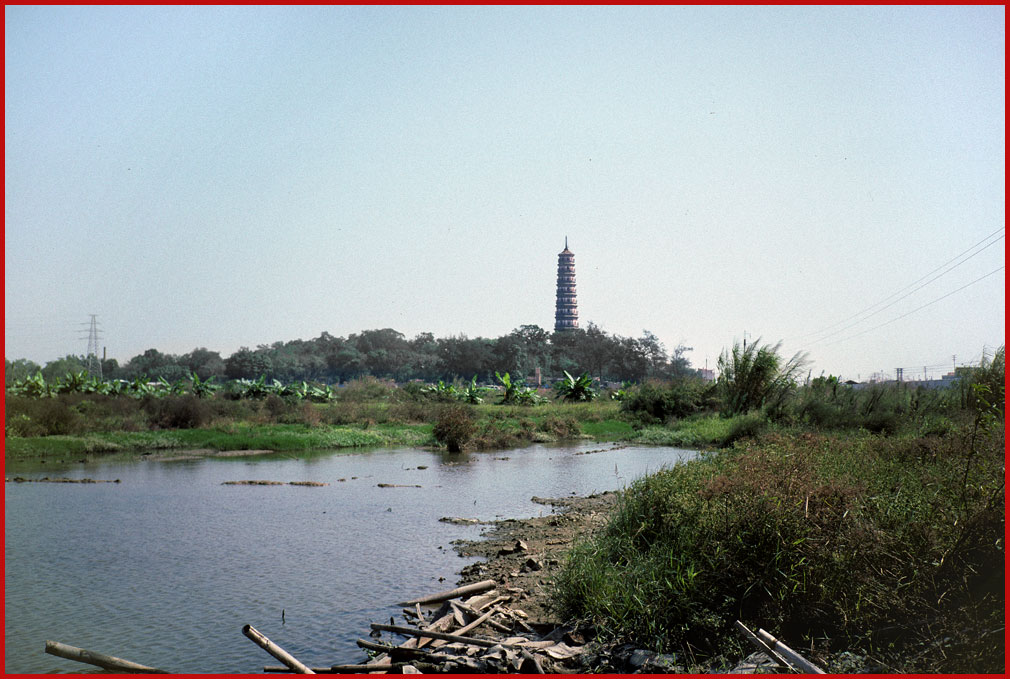
The Whampoa Pagoda (Pazhou
Pagoda)
The more than 400 years old
Pazhou pagoda on Whampoa Island in the Pearl River delta -
(Photography by Karsten Petersen)
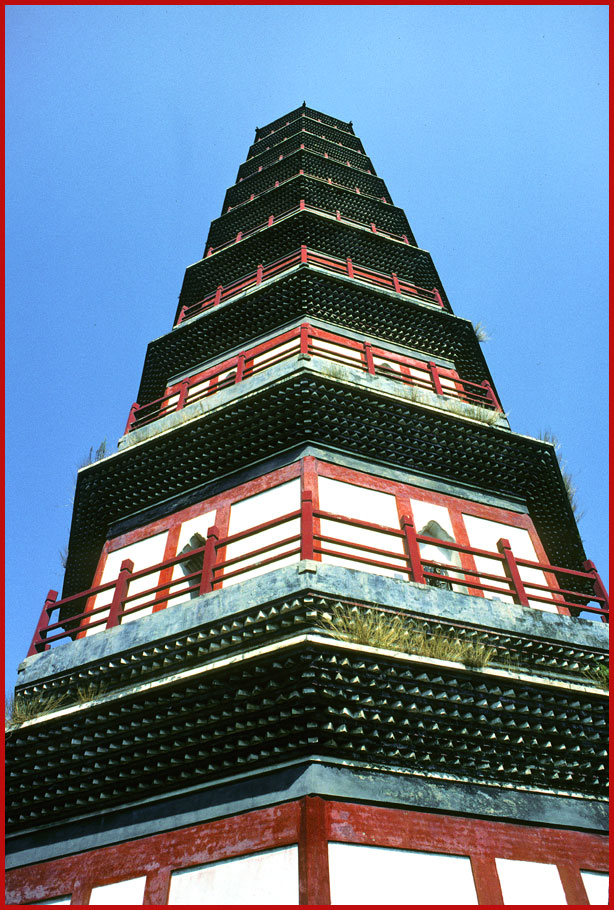
The Whampoa Pagoda (Pazhou
Pagoda)
Looking up all nine levels,
- almost 50 meters to the top -
(Photography by Karsten Petersen)
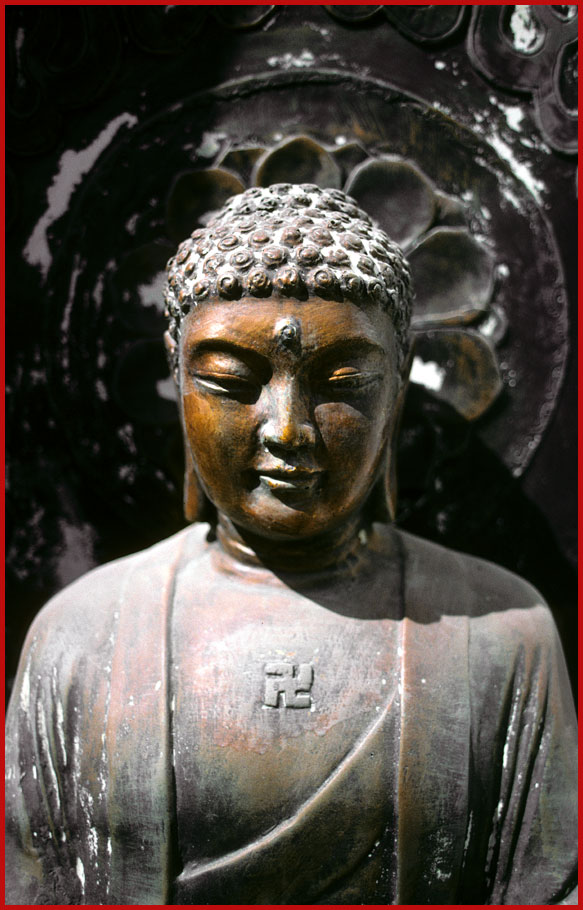
The Whampoa Pagoda (Pazhou
Pagoda)
- one of the many Buddha statues
that decorates the pagoda -
(Photography by Karsten Petersen)
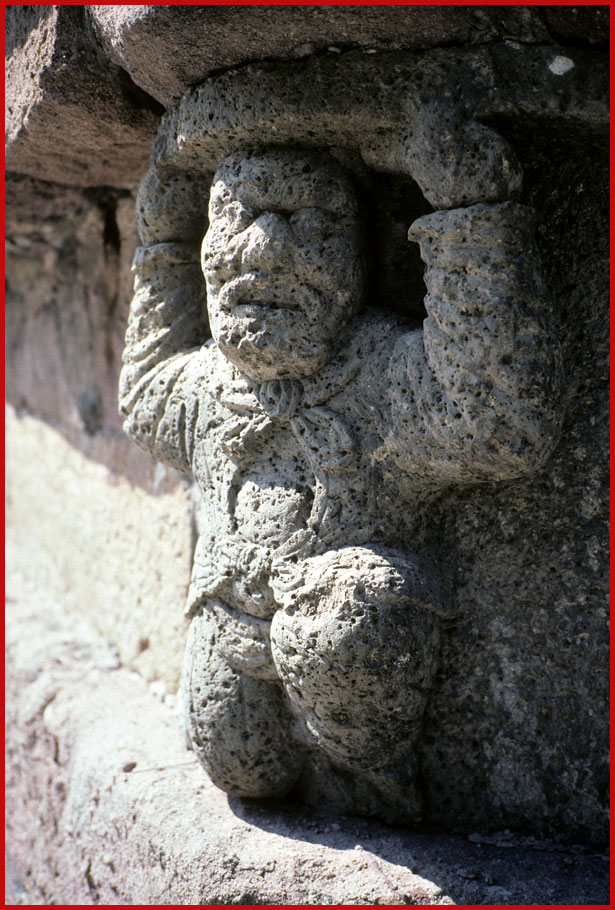
The Whampoa Pagoda
(Pazhou Pagoda)
The base has some wonderful
statues of giants that apparently carry the pagoda.
Take note of the obvious Western
look of this one! He is for sure NOT a Chinese - -
(Photography by Karsten Petersen)
With mission accomplished, it
was once more time to leave Danes Island, with it's history and ghosts
from the past.
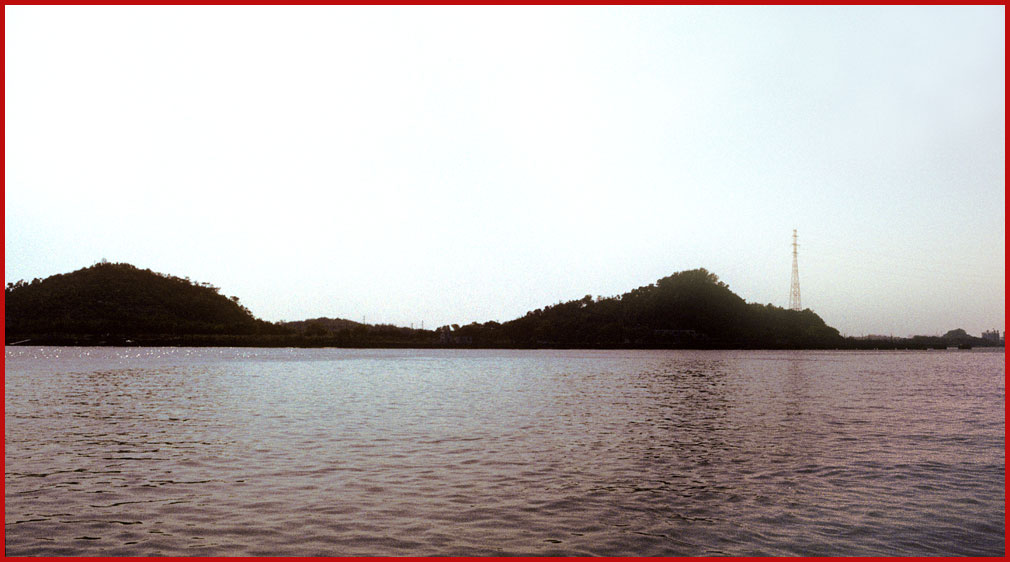
Danes Island
Leaving Danes Island,
- a last look back -
The grave site is on the hill
to the left of the antenna mast -
(Photography by Karsten Petersen)
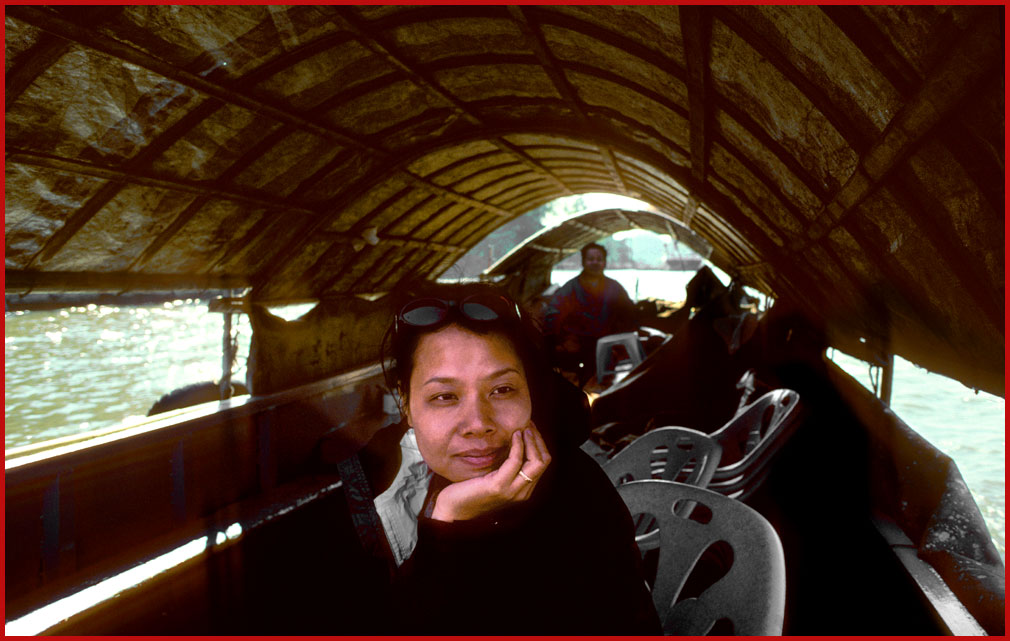
Kit Yu and I Leaving the island
by a local water taxi, - destination Whampoa.
At Whampoa I had to check out
some more interesting historical stuff, - this time Chinese history.
But that is another story -
(Photography by Karsten Petersen)
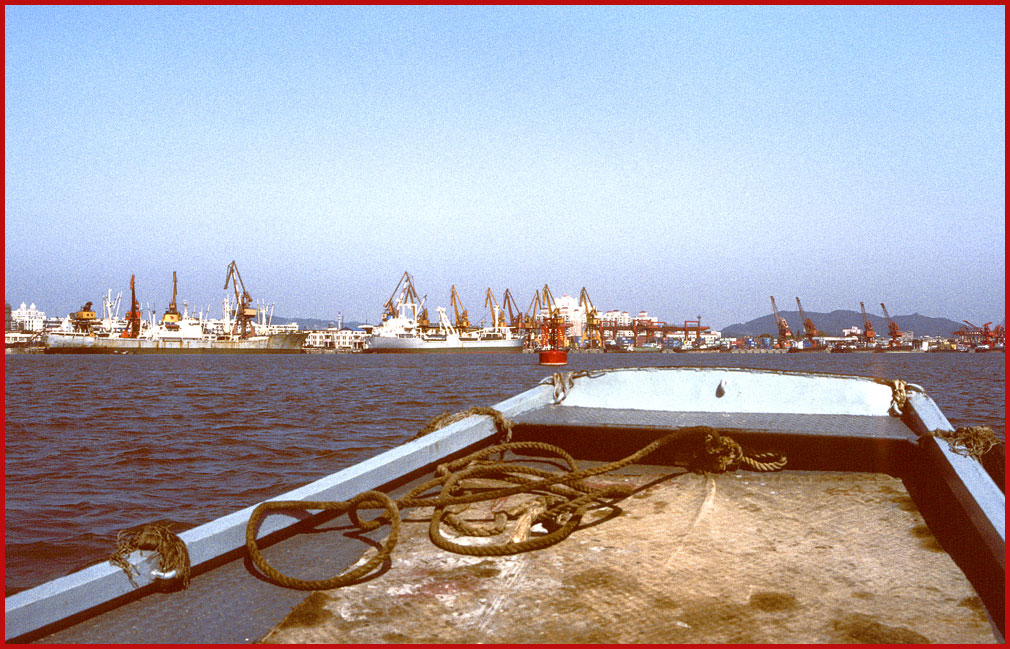
The Pearl River
- towards Whampoa with its
endless wharfs -
(Photography by Karsten Petersen)
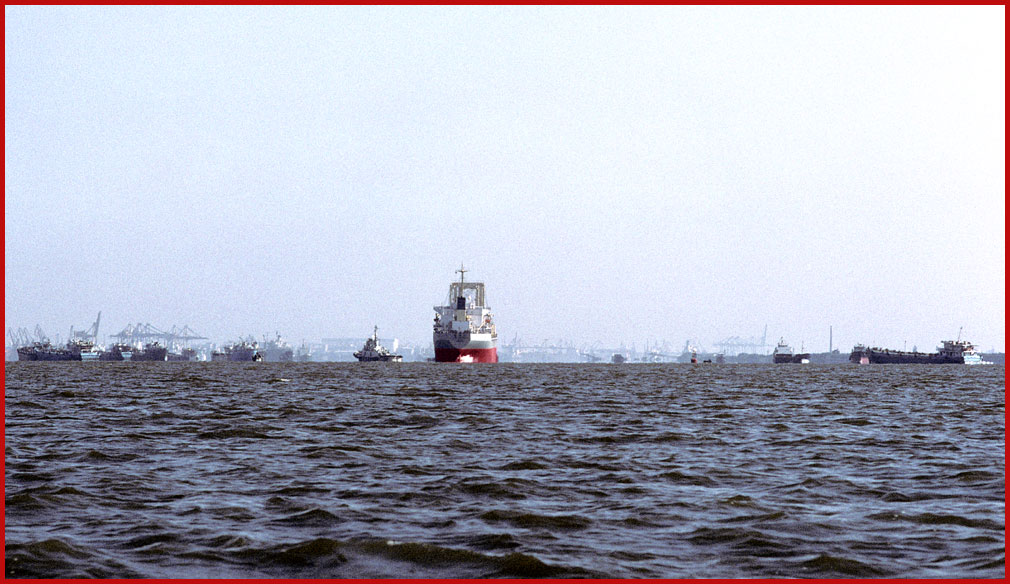
Pearl River
- crossing the mighty Pearl
River between Danes Island and Whampoa -
(Photography by Karsten Petersen)
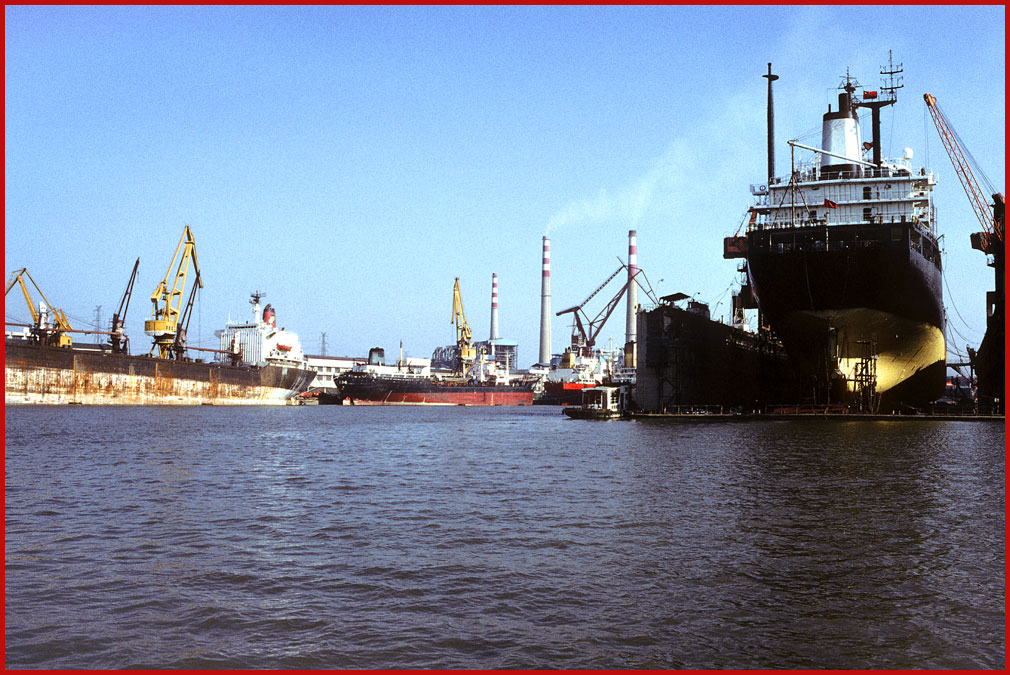
Pearl River
- along the modern Whampoa
wharfs and ship repair docks - and the end to my Danes Island adventure
-
(Photography by Karsten Petersen)
Finally:
The answers to my questions
in the beginning of this page:
Question No. 1:
Danes Island???
Did Denmark posses a colony in China???
Answer:
No! The name Danes Island
came from the fact, that the coast of this particular island was mainly
used as anchorage for the Danish ships, - hence the name Danes Island.
The same goes for French Island!
This is where the French ships dropped their anchor!
Question No. 2:
What did all those Western
ships do there at this place, - in the middle of nothing -, far from the
big city Canton???
They discharged and loaded
cargo into smaller cargo junks, which then brought the cargo to and from
Shamian Island at Canton, where the actual trade took place.
This is because the western
ships were forbidden go further up the river.
Reason was, that the Chinese
authorities were afraid to expose the local Chinese population to the bad
influence they might get from thousands of "primitive" and "barbarian"
Western sailors - - -
They had a point there, but
another reason made more sense: The Western ships were simply too big to
go all the way up to Shamian Island, so even if they were allowed to go
all the way up, they could not due to draft restrictions in the river -
- -
The other questions:
What was Danes Island? -
and what does it look like today?? - are fully answered in these web pages.
Please enjoy - - - :-)
Back to CHINA
MENU
Updated: Jan. 12. 2004
Nov. 17th. 2004
August 02. 2006
July 14.2008





























